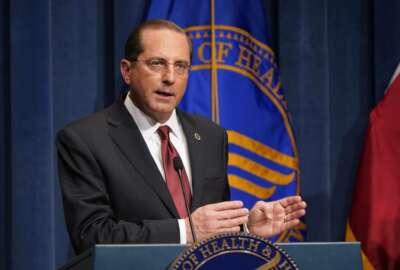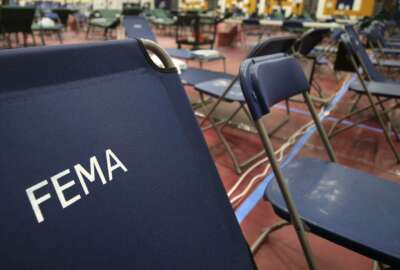FEMA suffering staffing shortages as natural disasters intensify
The number of natural disasters requiring a federal response seem to be on the rise. Yet the first- response agency FEMA suffers from staffing shortages. That's one...
Best listening experience is on Chrome, Firefox or Safari. Subscribe to Federal Drive’s daily audio interviews on Apple Podcasts or PodcastOne.
The number of natural disasters requiring a federal response seem to be on the rise. Yet the first- response agency FEMA suffers from staffing shortages. That’s one finding of a review by the Government Accountability Office. No agency can ensure mission success without the right people. The Federal Drive with Tom Temin got more from GAO’s director of Homeland Security and Justice issues Chris Currie.
Interview transcript:
Tom Temin: Mr. Currie, good to have you back.
Chris Currie: Thank you.
Tom Temin: Obviously, Congress asked you to look at FEMA. But what was the basis of this look-see, and what we’re trying to discover here?
Chris Currie: Well, we’ve been looking at FEMA’s workforce challenges for well over a decade, and after Hurricane Katrina, and this is in light of an increasing number of disasters, but not just total number of disasters, but increasing catastrophic disasters. So it used to be in the old days where FEMA was waiting in between large catastrophic disasters to deploy. But nowadays, what’s happening is they’re happening back to back and sometimes sequentially, which has a huge impact on their existing workforce.
Tom Temin: Well, when something does happen, do they just use the same people and send them where they’re needed? Or do they have some kind of a, I don’t know, adjunct faculty of part-time people that they can pull together, almost like the Postal Service trying to deliver those test kits?
Chris Currie: Yeah, that’s a great question. I mean, one of the misconceptions, I think, with FEMA is that they are just a response agency. So I think when people think of FEMA, they think of the TV or media after, for example, the Kentucky tornadoes recently, and they see FEMA and the president on the ground, talking to survivors. And you know, a big part of what they do is respond right after a disaster. But a large part of their workforce, actually, is involved in long term recovery efforts from prior disasters.
Last fall, FEMA told me they had almost 1,000 open emergency or disaster declarations from the current or the past. So that means is a lot of their people are actually processing recovery projects, rebuilding projects, all sorts of things from past disasters, for the example I like to use is that Hurricane Katrina is still open as an administrative disaster from 16 years ago.
Tom Temin: Yes. And when that happened, I think FEMA kind of had a role change to be much more early on in disaster response. Because prior to that wasn’t FEMA considered almost a secondary responder, they came in with the checks that people needed to get their businesses back running, or whatever it was their housing back together, but they weren’t there in the sense of first responders as you think of as dressing wounds and putting out fires literally, and putting up dams of sandbags to stave off floods.
Chris Currie: It’s still true today that all disaster response starts at the most local level, and you think about police, fire, EMS, things like that. But after Hurricane Katrina, FEMA was given the ability to be much more proactive, for example, before a hurricane strikes, they can go ahead and declare an emergency, deploy resources, start assisting the state and local government. And what we’ve seen over the last 10 to 15 years is they really do a pretty good job in the response phase. They’re very proactive. State and local officials we’ve talked to are really pleased with the help they get from FEMA right before and right after a disaster. I think what becomes frustrating around the country is these longer term recovery projects, where you know, it’s just basically becomes a paperwork and a financial issue of processing grants, building projects, kind of going back and forth with FEMA over the long haul. And so a lot of what FEMA workforce is doing, actually, much of it focuses on processing these grants and these payments and things like that, not on the response piece.
So FEMA needs a large response workforce, but it also needs a huge workforce of people to process through the backlog of recovery projects. And so what we’ve seen recently, and what we talked about in the hearing last week was that as FEMA has more responsibilities for disasters, but then you add on that their significant responsibilities and COVID. Other things they’ve been asked to do like help at the border and help resettle Afghan refugees. It just kind of brought their workforce to a breaking point.
Tom Temin: We’re speaking with Chris Currie, director of homeland security and justice issues at the Government Accountability Office. So the shortfall, then, is in that back office, cleaning up so that it should not take 16 years to wrap up the case, if you will, in a Katrina?
Chris Currie: Right. I mean, they have shortfalls in a lot of different pieces of their workforce. And when I say shortfalls, I don’t just mean total numbers because FEMA has hired around 5,000 to 6,000 new people in the last six years, which is a really good thing given their responsibilities. But, it’s not just how many people you’re hiring, it’s also who are you hiring, are they staying? And then what skills do they have that you need? And this is something that we’ve seen with FEMA in terms of retention. I mean, it’s often difficult to retain some of these folks, particularly, you said up front, they have a large reserve workforce, you know, reservists in this day and age with the economy are not easy to keep on staff.
Tom Temin: Well, with respect to the 5,000 or 6,000 people that they have got in the retention problem, what’s behind tha did you find? And what does FEMA say is the issue with retaining people because it sounds like work that is interesting, and also highly relevant to people’s lives.
Chris Currie: It is. And I think there is a component of FEMA’s workforce that feels strongly about public service. I mean, we get to work with them every day. I think they have a strong culture of public service and strong commitment to their mission.The former administrator of FEMA, Craig Fugate, testified with me at this congressional hearing. And one of the things he talked about is just when folks get on board with FEMA, sometimes they thought they were going to be involved in immediate response to disasters. But, I mentioned that a lot of what they do is processing grants and dealing with paperwork and things like that. And so, that may not be quite what they expected to do. And that factors into it. The other thing, too, is I mean, these are difficult jobs, reservists have to be ready to deploy, and they have to deploy all over the country for long periods of time. And that’s not something everybody’s in a position to do either because of their family or their professional situation. And we already have a huge employment challenge in this country right now. So they’re competing with other part-time engagements, gig economy, things like that, for people that might be wanting to serve in this role.
Tom Temin: And for people doing the work post-disaster, as he said, processing the grants, claims and so forth. And just seeing things are buttoned up is the learning curve long there because you’d have to know the federal grant system, you have to know a myriad of rules and regulations that are subject to challenge. You have to know federal finance, it seemed like it’s pretty specialized knowledge that would not ordinarily devolve to someone in a couple of weeks after joining.
Chris Currie: Yeah, that’s a great point. And training and qualification has been another challenge that we’ve pointed out. In fact, when we went out throughout the country and talked to FEMA field leaders, these are the folks that are responsible for leading disaster response and recovery throughout the country. They said that FEMA’s qualification and training processes are really not keeping pace with the needs. And it’s exacerbated when you hire lots of new people, because like you said, these programs are very technical, they require a lot of experience. And so field leaders had told us that, you know, oftentimes people would be deployed for a certain position or a certain responsibility. And it turns out, they didn’t really have the skills necessary to do that. So FEMA has a system they call FQS, or a FEMA Qualification System, to try to base the skills and training abilities and then deploy people if needed. And over the years, there has been a number of challenges with that system, being able to keep up with the needs in the field. And then you add on top of that, just the number of sequential or parallel disasters going on in this country, and it just gets almost unmanageable. Like I said, it used to be that there’d be a disaster, FEMA folks would go home, they’d have a chance to recoup, the agency would have a chance to reorganize and then get ready for the next hurricane season. That’s just not the case anymore. Every day is disaster season now at FEMA. It’s just compounded over the years. And one of the things we talked about at the hearing, and the former administrator did as well, is just the need to try to transform the workforce to meet what we expect it as a country to do in this day and age.
Tom Temin: So if you boiled it down to the hard nut of the problem, it’s training and education of the people they hire. And then presumably, if they’re better at what they’re doing quicker, they’ll stay longer.
Chris Currie: That’s part of it. I think it’s everything. I mean, on the front end it’s hiring, I mean, how do we make these jobs attractive and get people you want in them with the skills? And then once they’re in the door, how do you get them trained and qualified as quickly as possible? Because we found in the past that a lot of times reservists, they’re deployed, and because they can’t actually be paid unless they are working an active disaster, that they’re doing training and development on the disaster site. And that’s probably not the best environment for training and development. So, I think we need to look at flexibilities and authorities that allow FEMA, similar to what the military does allow, allow them to train and develop their folks possibly, you know, look at protections for them with their other jobs they may have if they are reservists or part time employees. And all of this is going to feed into retention as well. I mean, if this works well, and you get them on board, then you’re more likely to retain them, which means you’re more likely to retain the experienced people and you don’t have to focus so much on training. So it’s the whole picture and it’s kind of a big cycle. But we need to look at all of it.
Tom Temin: And of course, you mentioned Craig Fugate testified. Does the current theme of management recognize this problem and kind of agree with what you’re recommending?
Chris Currie: Absolutely. We actually met with the current administrator last Friday, and discussed the FEMA workforce, specifically. And yes, they are. First of all, they well understand the challenge that the workforce faces, and that there are significant reforms that need to be undertaken to address these challenges. And I think they’ve made that a top priority, at least in their strategic planning in their early plans.
Tom Temin: Chris Currie is director of homeland security and justice issues at the Government Accountability Office. Thanks so much.
Chris Currie: Thank you, Tom.
Copyright © 2025 Federal News Network. All rights reserved. This website is not intended for users located within the European Economic Area.
Tom Temin is host of the Federal Drive and has been providing insight on federal technology and management issues for more than 30 years.
Follow @tteminWFED






